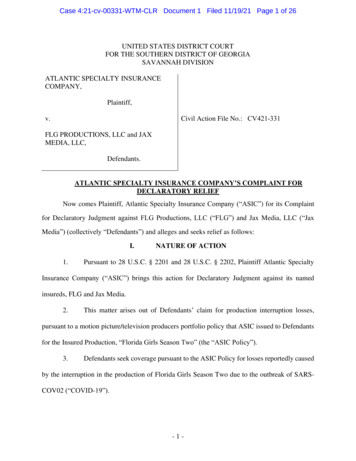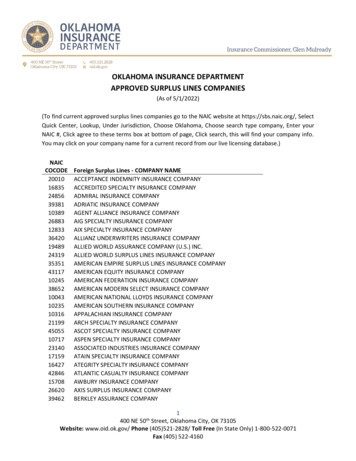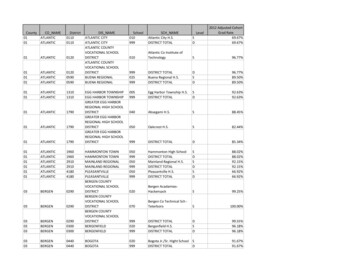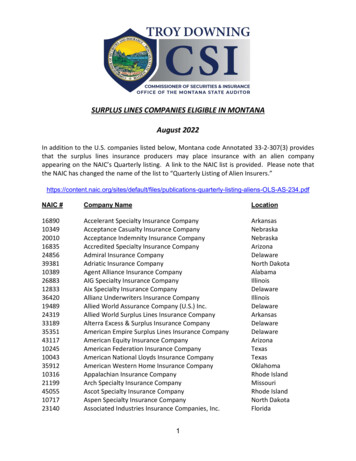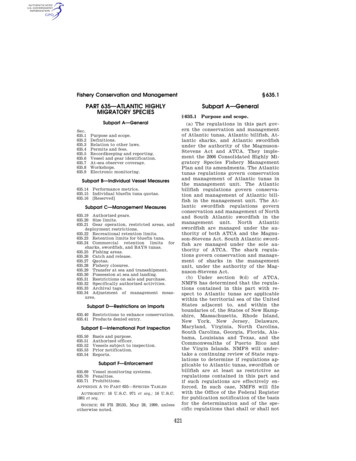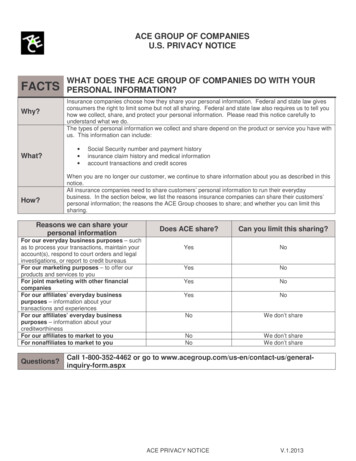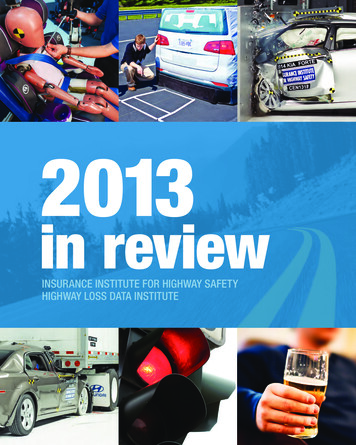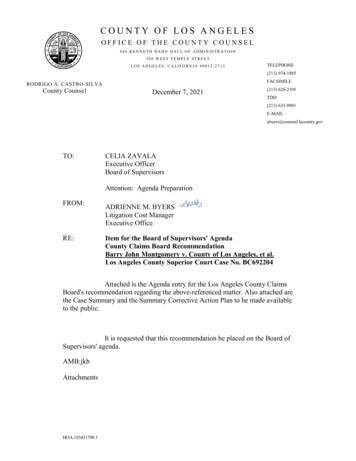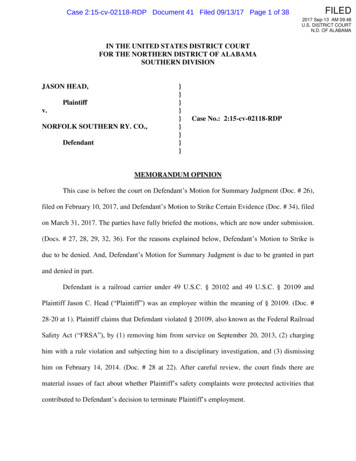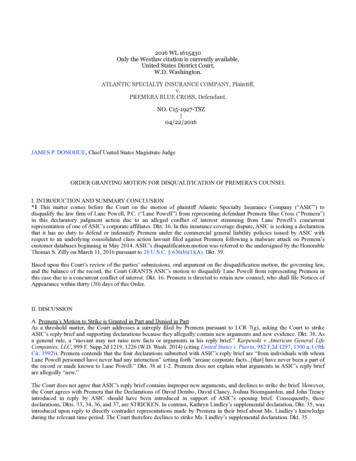
Transcription
2016 WL 1615430Only the Westlaw citation is currently available.United States District Court,W.D. Washington.ATLANTIC SPECIALTY INSURANCE COMPANY, Plaintiff,v.PREMERA BLUE CROSS, Defendant.NO. C15-1927-TSZ 04/22/2016JAMES P. DONOHUE, Chief United States Magistrate JudgeORDER GRANTING MOTION FOR DISQUALIFICATION OF PREMERA’S COUNSELI. INTRODUCTION AND SUMMARY CONCLUSION*1 This matter comes before the Court on the motion of plaintiff Atlantic Specialty Insurance Company (“ASIC”) todisqualify the law firm of Lane Powell, P.C. (“Lane Powell”) from representing defendant Premera Blue Cross (“Premera”)in this declaratory judgment action due to an alleged conflict of interest stemming from Lane Powell’s concurrentrepresentation of one of ASIC’s corporate affiliates. Dkt. 16. In this insurance coverage dispute, ASIC is seeking a declarationthat it has no duty to defend or indemnify Premera under the commercial general liability policies issued by ASIC withrespect to an underlying consolidated class action lawsuit filed against Premera following a malware attack on Premera’scustomer databases beginning in May 2014. ASIC’s disqualification motion was referred to the undersigned by the HonorableThomas S. Zilly on March 11, 2016 pursuant to 28 U.S.C. § 636(b)(1)(A). Dkt. 39.Based upon this Court’s review of the parties’ submissions, oral argument on the disqualification motion, the governing law,and the balance of the record, the Court GRANTS ASIC’s motion to disqualify Lane Powell from representing Premera inthis case due to a concurrent conflict of interest. Dkt. 16. Premera is directed to retain new counsel, who shall file Notices ofAppearance within thirty (30) days of this Order.II. DISCUSSIONA. Premera’s Motion to Strike is Granted in Part and Denied in PartAs a threshold matter, the Court addresses a surreply filed by Premera pursuant to LCR 7(g), asking the Court to strikeASIC’s reply brief and supporting declarations because they allegedly contain new arguments and new evidence. Dkt. 38. Asa general rule, a “movant may not raise new facts or arguments in his reply brief.” Karpenski v. American General LifeCompanies, LLC, 999 F. Supp.2d 1219, 1226 (W.D. Wash. 2014) (citing United States v. Puerta, 982 F.2d 1297, 1300 n.1 (9thCir. 1992)). Premera contends that the four declarations submitted with ASIC’s reply brief are “from individuals with whomLane Powell personnel have never had any interaction” setting forth “arcane corporate facts.[that] have never been a part ofthe record or made known to Lane Powell.” Dkt. 38 at 1-2. Premera does not explain what arguments in ASIC’s reply briefare allegedly “new.”The Court does not agree that ASIC’s reply brief contains improper new arguments, and declines to strike the brief. However,the Court agrees with Premera that the Declarations of David Dembo, David Clancy, Joshua Boomgaarden, and John Treacyintroduced in reply by ASIC should have been introduced in support of ASIC’s opening brief. Consequently, thesedeclarations, Dkts. 33, 34, 36, and 37, are STRICKEN. In contrast, Kathryn Lindley’s supplemental declaration, Dkt. 35, wasintroduced upon reply to directly contradict representations made by Premera in their brief about Ms. Lindley’s knowledgeduring the relevant time period. The Court therefore declines to strike Ms. Lindley’s supplemental declaration. Dkt. 35.
B. Factual and Procedural History1. OneBeacon’s Wholly-Owned Subsidiaries, ASIC and Homeland*2 ASIC and Homeland Insurance Company of New York (“Homeland”) are two wholly- owned subsidiaries of theOneBeacon Insurance Group, LLC (“OneBeacon”).1 Dkt. 17 (Lindley Decl.) at ¶ 1-2; Dkt. 18 (Arends Decl.) at ¶ 2. AllOneBeacon member companies share the same mailing address and principal place of business. Dkt. 18 (Arends Decl.) at ¶ 2.These entities’ operations are structured so that claims-handling services for all OneBeacon companies are handled by thesame internal Claims Unit personnel, who are all employees of ASIC, with the claims leadership located in Plymouth,Minnesota. Dkt. 17 (Lindley Decl.) at ¶ 4; Dkt. 18 (Arends Decl.) at ¶ 3.The Claims Legal Unit acts as an internal legal resource to all OneBeacon claims personnel, and together with the primaryClaims Attorney or other assigned claim handler, the Claims Legal Unit is involved in all insurance coverage litigationcommenced by or against the OneBeacon companies, including ASIC and Homeland. Dkt. 17 (Lindley Decl.) at ¶ 6.Homeland has no employees. Dkt. 17 (Lindley Decl.) at ¶ 4; Dkt. 18 (Arends Decl.) at ¶ 3. All claims handled by the ClaimsUnit report up through various levels of management to the Chief Claims Officer, including the VP Claims Legal, the VPSpecialty Property and Casualty (“SP&C”) Liability Claims, and the Vice-Presidents of other units. Dkt. 18 (Arends Decl.) at¶ 4.The SP&C Liability team handles property and casualty liability claims for the OneBeacon Environmental and OneBeaconFinancial Services business units, among others, including claims under the Commercial General Liability (“CGL”) primaryand excess policies issued by both ASIC and Homeland. Dkt. 18 (Arends Decl.) at ¶ 5. The claims attorneys on the SP&CLiability team are managed by Vice President of SP&C Liability Claims Cynthia Arends. Id. Relevant to this action, claimsattorney Kathryn Lindley was part of the SP&C Liability team under Ms. Arends’ supervision. Id.22. Lane Powell’s Representation of OneBeacon’s Homeland in the AAM MatterIn late July 2015, OneBeacon received a claim under the CGL policy issued by OneBeacon’s Homeland to AAM, Inc. (the“AAM matter”). The AAM matter was a coverage dispute arising from an employee injury lawsuit against AAM. Ms.Lindley was assigned to handle that claim in early August 2015. Dkt. 18 (Arends Decl.) at ¶ 6. On August 13, 2015, Ms.Lindley engaged Lane Powell attorney William Patton, who is based in Portland, to represent Homeland. Dkt. 17 (LindleyDecl.) at ¶¶ 9-14; Dkt. 18 (Arends Decl.) at ¶¶ 6-7. On August 14, 2015, Ms. Lindley received an email from Mr. Pattonstating, “I have confirmed that there is no conflict, so we can proceed.” Dkt. 17 (Lindley Decl.) at ¶ 10. Ms. Lindley wasadvised that the other Lane Powell attorneys who would work on the matter were Steve Jensen, a shareholder in the Seattleoffice, and Matthew Kirkpatrick, an associate attorney in the firm’s Portland office. Id. at ¶ 12.All of Ms. Lindley’s emails to Mr. Patton and the other attorneys at Lane Powell came from her OneBeacon email account(onebeacon.com), and her signature block clearly identified her as a claims attorney for OneBeacon Environmental. Id. at ¶¶11, 14. Surprisingly, no formal engagement letter was ever executed. However, Ms. Lindley sent Mr. Jensen a documententitled “OneBeacon Insurance Company Counsel Case Handling Guidelines” on August 19, 2015, as well as a copy of aform letter on “OneBeacon Insurance” letterhead providing instructions for the “OneBeacon Insurance” online invoicesubmission system. Id. at ¶ 13; Dkt. 17 (Lindley Decl.), Ex. 1. The OneBeacon Insurance Company Counsel Case HandlingGuidelines discuss the relationship between outside counsel and the client, which is identified as “OneBeacon Insurance, andits specialty business segments.” Dkt. 17 (Lindley Decl.), Ex. 1 (emphasis added). For example, the mission statementprovides that “OneBeacon Insurance, and its specialty business segments, believe in securing high-quality, cost-effect serviceto represent its interests.we strive for close collaboration with company counsel to resolve litigation and/or legal matters atthe best possible value.” Id.*3 Lane Powell’s representation of Homeland in the AAM matter from August 2015 through January 2016 involved the LanePowell attorneys providing legal advice to Ms. Lindley, and seeking a declaration that Homeland had no duty to defend orindemnify the defendants in the underlying action, Homeland Ins. C. of N.Y. v. AAM, Inc., No. 3:15-cv-01745-PK (D. Ore.).Lane Powell’s representation included drafting multiple reservation-of-rights letters, discussing a possible declaratoryjudgment action with Ms. Lindley and other members of OneBeacon’s Claims Legal department, drafting a declaratoryjudgment complaint, participating in court-mandated scheduling conferences, and researching and preparing a draft brief insupport of a motion for summary judgment. Dkt. 17 (Lindley Decl.) at ¶¶ 15-17. Ms. Lindley asserts in her declaration thatshe and OneBeacon’s Claims Legal department members had extensive discussions with Lane Powell regarding OneBeacon’slitigation strategy in coverage actions, its view of policy interpretation, its perspective on Washington insurance law, andrelated matters. Dkt. 17 (Lindley Decl.) at ¶¶ 15-17. See also Dkt. 18 (Arends Decl.) at ¶ 7 (“Prior to commencing the
declaratory judgment action in the AAM matter, I participated in strategy discussions with Ms. Lindley and the Claims Legalattorneys.to formulate OneBeacon’s position and approve the direction provided to our outside counsel, Lane Powell.”).3. Lane Powell’s Representation of PremeraOn March 17, 2015, Lane Powell was formally engaged to represent Premera with respect to the cyberattack that is the basisof the underlying class action. Dkt. 24 (Payton Decl.) at ¶ 3. Lane Powell has represented Premera with respect tocommercial litigation and regulatory issues, including liability insurance, for over nineteen years. Id. at ¶ 2. GwyndolynPayton, a shareholder in Lane Powell’s Seattle office, asserts that she has been Premera’s primary contact for the bulk of thattime, although she is sometimes joined by Seattle shareholder John Neeleman, such as in matters implicating actual orpotential liability insurance coverage disputes. Id. at ¶¶ 2-3. Ms. Payton asserts that Lane Powell’s representation of Premerafollowing the cyberattack has included providing advice regarding liability insurance for the cyberattack, and that such advicewas provided to Premera “well before August 2015.” Id.at ¶ 3.3OneBeacon’s ASIC issued Premera two “@vantage for Financial Services Premier” liability insurance policies at issue in thisdeclaratory judgment action. The first policy was effective from October 1, 2013 through October 1, 2014. Dkt. 1, Ex. B-3.The second policy was effective from October 1, 2014 through October 1, 2015. Dkt. 1, Ex. C-3. Both policies providedprimary and umbrella commercial general liability coverage.Ms. Lindley was assigned to the Premera insurance-coverage claim under the primary and umbrella CGL coverages issued byASIC. Dkt. 17 (Lindley Decl.) at ¶ 18, Ex. B and C; Dkt. 18 (Arends Decl.) at ¶ 8. Before the class action complaint wasfiled, Premera had tendered a number of individual lawsuits arising out of the data breach to ASIC, seeking coverage underthe ASIC policies. By letter dated July 2, 2015, ASIC agreed to defend Premera against the first tendered individual lawsuit,Webb, et. al., v. Premera Blue Cross, under a complete reservation of its rights under the ASIC policies and applicable law.Dkt. 17 (Lindley Decl.) at ¶ 19. Specifically, Ms. Lindley sent a letter on “OneBeacon Financial Services” letterhead and thesubject line of the letter identified the underwriter as “Atlantic Specialty Insurance Company (OneBeacon),” with a signatureblock identifying her as “Claims Consultant, OneBeacon Financial Services” and an email address ofklindley@onebeacon.com. Id. Similarly, after ASIC learned that all of the individual lawsuits arising from the Premera databreach were to be consolidated into a class action filed in the U.S. District Court for the District of Oregon, Ms. Lindleyadvised Premera by supplemental letter dated July 31, 2015 that ASIC was reserving all of its rights under the ASIC policiesand applicable law as to all of the individual lawsuits filed against Premera arising out of the same data breach. Id.*4 Ms. Lindley was advised by Premera’s broker in July 2015 that Premera had retained Lane Powell to represent it as localcounsel in defending the underlying data breach actions, a role that was not adverse to OneBeacon because OneBeacon andPremera’s interests were aligned in defending against the class action. Dkt. 35 (Second Lindley Decl.) at ¶ 9. Specifically, byemail dated July 15, 2015, Ms. Lindley confirmed her understanding that Lane Powell was representing Premera with regardto the individual lawsuits arising from the cyberattack. Dkt. 28, Ex. 2 (noting that OneBeacon has offered Premera a defenseunder a reservation of rights with regard to one of the individual lawsuit under the CGL coverage, and commenting that “itwould also be helpful to know what rates Lane Powell, who we understand is acting as local counsel, is charging[.]”).However, Ms. Lindley was not advised by Premera, Premera’s broker, or Lane Powell that Lane Powell was also acting asPremera’s coverage counsel. Dkt. 35 (Second Lindley Decl.) at ¶ 9.On August 7, 2015, Lane Powell appeared on behalf of Premera in the underlying class action. The class action complaintwas filed on October 6, 2015. By letter dated November 6, 2015, Ms. Lindley acknowledged receipt of the class actioncomplaint and agreed to defend Premera against the lawsuit, again, under a complete reservation of its rights under the ASICpolicies and applicable law. Dkt. 17 (Lindley Decl.) at ¶ 19. These letters were also sent on the OneBeacon Financial Servicesletterhead, identified the underwriter as “Atlantic Specialty Insurance Company (OneBeacon)”, and identified OneBeaconFinancial Services in the signature block. Id. Although neither party has provided evidence that Lane Powell, as Premera’scoverage counsel, received copies of the Reservations of Rights letters sent from ASIC to Premera, during oral argument Ms.Payton conceded that Lane Powell likely reviewed these letters and therefore knew about the potential adversity to ASIC asearly as July 2, 2015, when Ms. Lindley sent the first letter.On December 8, 2015, OneBeacon’s ASIC initiated this action against Premera, seeking a declaration pursuant to 28 U.S.C.§§ 2201 and 2202 that it has no duty to defend or indemnify Premera under the CGL coverage against the data-breach claimsasserted against it in the consolidated class action. Dkt. 1. See also Dkt. 17 (Lindley Decl.) at ¶ 20; Dkt. 18 (Arends Decl.) at¶ 9. On December 21, 2015, Ms. Payton and Mr. Neeleman filed Notices of Appearance on behalf of Premera in this case.Dkts. 10-11.4Ms. Lindley was not aware that Lane Powell was acting as Premera’s insurance coverage counsel until December 21, 2015,when Ms. Payton and Mr. Neeleman’s Notices of Appearance were filed. Dkt. 17 (Lindley Decl.) at ¶ 22. Lane Powell did not
contact OneBeacon to advise the company of the representation, discuss whether the representation presented a conflict, orrequest a waiver. Id. Ms. Lindley immediately contacted attorney Mr. Kirkpatrick to alert him to her belief that Lane Powellhad a conflict of interest on December 21, 2015, and in response to a voice-mail message from Mr. Patton, also “subsequentlydiscussed the conflict with both Mr. Patton and Mr. Jensen” on December 22, 2015. Id. at ¶ 23.During this conversation, Mr. Jensen advised Ms. Lindley that he was unaware that Mr. Neeleman and Ms. Payton hadappeared in the Premera action, adverse to ASIC, until Ms. Lindley brought it to his attention. Id.; see also Dkt. 26 (JensenDecl.) at ¶¶ 3-4. However, Ms. Lindley asserts that “Mr. Jensen told me that Mr. Neeleman was aware of the relationshipbetween ASIC and Homeland before appearing in the Premera action and that Mr. Neeleman did not believe there was aconflict and would not withdraw.” Id. (emphasis added). Mr. Jensen denies making this representation. Dkt. 26 (Jensen Decl.)at ¶ 5 (“I have no knowledge whatsoever to the effect that Mr. Neeleman was aware of a relationship between [ASIC] andHomeland prior to Lane Powell PC entering a notice of appearance on behalf of Premera. Mr. Neeleman has never stated tome that he had any such awareness.”). See also Dkt. 27 (Patton Decl.) at ¶ 5.5 Mr. Neeleman also denies making such astatement, and asserts that he had never heard of Homeland until Mr. Patton telephoned him on December 21, 2015 to informhim of the alleged conflict, at which time Mr. Neeleman “informed [Mr. Patton] that Homeland must be mistaken, because Ihad for the past three years been personally representing clients (the Anova companies) adverse to [ASIC], and thatrepresentation and adversity was still ongoing.” Dkt. 28 (Neeleman Decl.) at ¶ 9.*5 Following Ms. Lindley’s December 22, 2015 discussion with Mr. Jensen and Mr. Patton, Ms. Lindley spoke with RandallBeighle, Lane Powell’s internal General Counsel, on December 28, 2015, and expressed her concern that Lane Powell was ina conflict of interest position because Ms. Lindley had engaged Lane Powell to represent Homeland to the AAM matter, andthe plaintiff in this case, ASIC, is a sister corporation of Homeland. Dkt. 17 (Lindley Decl.) at ¶ 24; Dkt. 25 (Beighle Decl.)at ¶ 2. Mr. Beighle told Ms. Lindley that he would look into the situation and provide a response following an investigation.Dkt. 25 (Beighle Decl.) at ¶ 2. On January 14, 2016, Ms. Lindley, her supervisor Ms. Arends, and Mr. Beighle discussed thematter further by telephone. Dkt. 17 (Lindley Decl.) at ¶ 25; Dkt. 18 (Arends Decl.) at ¶ 10; Dkt. 25 (Beighle Decl.) at ¶ 2.During that call, Mr. Beighle advised Ms. Lindley and Ms. Arends that there had been a problem with Lane Powell’s August2015 conflicts check and Lane Powell, for the first time, had identified an earlier conflict with respect to Lane Powell’srepresentation of Homeland in the AAM matter. Dkt. 17 (Lindley Decl.) at ¶ 24; Dkt. 18 (Arends Decl.) at ¶ 10. Mr. Beighleexplained that Lane Powell had a prior representation adverse to ASIC that preceded the Homeland representation (on behalfof a company called Anova Foods LLC) and that representation was still ongoing. Dkt. 25 (Beighle) at ¶ 3. Mr. Beighle statedthat Lane Powell did not believe there was an “actual conflict of interest” because affiliates are not presumptively clients ofactual clients. Id. He told Ms. Lindley and Ms. Arends that Lane Powell would agree to ask Anova Foods LLC and Premerafor waivers that would enable Lane Powell to continue to represent Homeland, and advised them that neither Ms. Payton norMr. Neeleman work with Mr. Patton or Mr. Jensen or have access to the Homeland materials. Id. at ¶ 6.Although Mr. Beighle may have understood the Anova Foods case to have presented a concurrent conflict of interest at thetime of his conversation with Mr. Lindley and Ms. Arends, Lane Powell now appears to concede that the alleged “priorconflict” that formed the basis of Lane Powell’s withdrawal/termination from the AAM matter was no longer a concurrentconflict. Specifically, Lane Powell had represented an ASIC policyholder, Anova Food, LLC (and its predecessor AnovaFood, Inc.) in an ongoing coverage dispute prior to the AAM matter. Dkt. 17 (Lindley Decl.) at ¶ 26; see also Dkt. 28(Neeleman Decl.) at ¶ 2 (“Since November 30, 2012, Lane Powell has been representing Anova Food LLC.in a still-ongoingcoverage dispute with [ASIC] that apparently will now be finally resolved through coverage litigation.”).6 However, the partof OneBeacon’s business that included the Anova claim was sold to Armour Risk effective December 2014, at which pointthe claim person handling the Anova matter ceased to be an ASIC employee and ASIC’s handling of the Anova claim alsoceased. Dkt. 17 (Lindley Decl.) at ¶ 26. Because the book containing the Anova claim was sold to a third party in December2014, there was no relationship between ASIC and Anova in August 2015, when Lane Powell undertook the representation ofHomeland. Id. Thus, there was no concurrent conflict of interest that necessitated Lane Powell’s withdrawal from the AAMmatter. Id.; Dkt. 18 (Arends Decl.) at ¶ 10 (“As Mr. Beighle described this alleged earlier conflict, it was immediately clear tome that this prior matter was not similarly situated, most notably because it was not a claim being handled within the SP&CLiability team.”).*6 Mr. Beighle asserts that during his communications with Ms. Lindley, he was never told that the book containing theAnova claim had been sold by OneBeacon to a third party in December 2014, or that there was therefore no longer anongoing relationship between OneBeacon and Anova in August 2015, when Lane Powell undertook its representation ofHomeland. Dkt. 25 (Beighle) at ¶ 5. Mr. Beighle asserts, however, that this fact would not have obviated Lane Powell’s needto obtain a waiver from Anova LLC in any event, as ASIC remains Anova LLC’s opponent. Id.The parties offer slightly differing accounts of how Lane Powell withdrew, or was terminated, from the AAM matter.However, what is clear is that Lane Powell’s representation of Homeland was extinguished when the firm refused tovoluntarily withdraw from its representation of Premera in this case.
As noted above, during the January 14, 2016 call, Mr. Beighle advised Ms. Lindley and Ms. Arends that Lane Powell wouldagree to ask Anova Foods LLC and Premera for waivers that would enable Lane Powell to continue to represent Homeland.Id. at ¶ 6. Ms. Lindley responded that she regarded Homeland and ASIC as indistinguishable, and therefore ASIC wouldagree to a waiver with respect to the Anova representation by Lane Powell but not the Premera representation. Id. at ¶ 7. Mr.Beighle stated that the firm was going to withdraw from the AAM action regardless of whether OneBeacon would waive thealleged conflict with Anova, and Lane Powell would not voluntarily withdraw from its representation of Premera in thismatter. Dkt. 17 (Lindley Decl.) at ¶ 26; Dkt. 18 (Arends Decl.) at ¶ 10; Dkt. 25 (Beighle Decl.) at ¶ 3 (“I told Ms. Lindley andMs. Arends that Lane Powell would not withdraw from the Premera case.”). Ms. Arends “followed up and asked Mr. Beighleto confirm that despite the fact that he was referencing an earlier alleged conflict, in reality, Lane Powell’s decision towithdraw from the AAM matter was due to its later appearance in the Premera matter and Mr. Beighle stated ‘yes.’ ” Dkt. 18(Arends Decl.) at ¶ 10. Ms. Lindley then informed Mr. Beighle that OneBeacon would be filing a motion to disqualify LanePowell in this case. Dkt. 17 (Lindley Decl.) at ¶ 28; Dkt. 18 (Arends Decl.) at ¶ 10.7Following the phone call, OneBeacon instructed its counsel to prepare a motion to disqualify Lane Powell in this action, andhired replacement counsel in the AAM matter. Dkt. 17 (Lindley Decl.) at ¶¶ 28-29. Ms. Lindley then wrote to Mr. Jensen onJanuary 19, 2016 and terminated Lane Powell for Homeland, instructing the firm to transfer the files to a new law firm. Dkt.25 (Beighle Decl.) at ¶ 8.Until the dispute that led to ASIC’s motion to disqualify Lane Powell in this case, Ms. Payton asserts that she was unawarethat ASIC was affiliated with Homeland, and she has not had any access to the materials related to Lane Powell’srepresentation of Homeland. Dkt. 24 (Payton Decl.) at ¶ 4. Lane Powell has a screen in place to block access to the AAM,Inc. physical file and electronic documents. Dkt. 25 (Beighle Decl.) at ¶ 9. In addition, the only persons who have accessedthe documents related to the AAM litigation are Lane Powell attorneys Mr. Jenson, Mr. Patton, Mr. Kirkpatrick, and Mr.Beighle. Id.C. Summary of the Parties’ Contentions*7 ASIC alleges that Lane Powell has a concurrent conflict of interest and must be disqualified from representing Premera inthis declaratory judgment action, adverse to OneBeacon’s ASIC, because at the time Lane Powell appeared in this case asPremera’s coverage counsel the firm was already representing OneBeacon’s Homeland in a separate declaratory judgmentaction. ASIC argues that the client in both declaratory judgment actions was ultimately the same OneBeacon Claims LegalUnit, as evidenced by the fact that the same claims attorney Ms. Lindley was assigned to both cases. ASIC further argues thatLane Powell was exposed to confidential client information about OneBeacon’s operations and coverage litigation strategiesduring the Homeland representation, and therefore cannot continue to represent Premera as coverage counsel in this action.ASIC asserts that Lane Powell’s representation of Premera in this case presents a concurrent conflict of interest under RPC1.7 as there were several weeks of concurrent representation when Lane Powell was representing Homeland in the AAMmatter and also Premera adverse to ASIC in the present case, and Lane Powell’s attempt to terminate the lawyer-clientrelationship with OneBeacon’s Homeland did not cure the problem. Dkt. 16 at 6-7.ASIC asserts that even if the Court finds that the less restrictive RPC 1.9 applies, a lawyer who has formerly represented aclient in a matter shall not thereafter represent another person in the same or a substantially related matter in which thatperson’s interests are materially adverse to the interests of the former client unless the former client gives informed consent,confirmed in writing. RPC 1.9(a). A matter is substantially related “if there otherwise is a substantial risk that confidentialfactual information as would normally have been obtained in the prior representation would materially advance the client’sposition in the subsequent matter.” RPC 1.9 cmt. 3. ASIC asserts that like the AAM matter, this case involves a dispute over aduty to defend under a OneBeacon commercial general liability policy. ASIC argues that Lane Powell’s extensive discussionswith Ms. Lindley and OneBeacon’s Claims Legal department in the AAM matter, learning OneBeacon’s litigation strategy incoverage actions, view of policy interpretation, and perspective on Washington insurance law and related matters constituteconfidential client information that must result in Lane Powell’s disqualification in this case so that Lane Powell may not usethe confidential information about OneBeacon’s operations to its disadvantage. Dkt. 16 at 8-9 (citing Jones v. Rabanco, Ltd.,2006 WL 2237708, at *4 (W.D. Wash. Aug. 3, 2006)). ASIC points out that matters can be “substantially related” for RPC 1.9purposes where facts that would have been learned in the earlier representation “reveal the client’s pattern of conduct.” Ali v.American Seafoods Co., LLC, 2006 WL 1319449, at *4 (W.D. Wash. 2006).Premera responds that Lane Powell has always been adverse to ASIC. Dkt. 23 at 3. When Ms. Lindley retained Lane Powellto represent Homeland in the AAM matter, the firm had been adverse to ASIC in the Anova litigation since November 2012,had already been engaged by Premera with respect to the cyberattack, and Ms. Lindley was already aware of the fact that thefirm was representing Premera in the individual lawsuits and underlying class action related to the data breach. Id. at 5.Premera further argues that no one at the firm was aware of the relationship between Homeland and ASIC before Ms. Lindleyraised the issue, and in fact “[o]nly Ms. Lindley had this information, and yet she made no effort to educate Lane Powell as to
it.” Id. at 10.8With respect to ASIC’s assertion that there was a concurrent conflict of interest due to ASIC and Homeland’s status assubsidiaries of OneBeacon, Premera responds that Lane Powell was terminated by Homeland on January 19, 2016, whichresolved any potential conflict and makes Homeland a former client of the firm. Premera argues that corporate affiliates ofactual clients are not presumptively clients themselves, as an attorney-client relationship with one member of a corporatefamily does not presumptively give rise to attorney-client relationships with all others. Premera asserts that this Court hasapplied the “appearance of impropriety” standard to determine whether disqualification should occur based upon RPC 1.7notwithstanding the absence of an attorney-client relationship with the moving party. Dkt. 23 at 8 (citing Rabanco, 2006 WL2237708, at *4 (holding that although the law firm was currently representing Rabanco’s wholly-owned subsidiary and notRabanco, “the appearance of impropriety would be too great if [the law firm] were to continue to represent Plaintiffs againstRabanco”)). Premera contends that there is no appearance of impropriety here, as Lane Powell was retained by Ms. Lindleyto represent Homeland exclusively, and with full knowledge that Lane Powell was adverse to ASIC and was representingPremera in the cyberattack litigation underlying this case. Premera asserts that if ASIC “has genuine concerns about conflictsof interest on the part of Lane Powell, it has only itself to blame,” as ASIC “itself bears responsibility for the conflict ofinterest problem that it alleges.” Dkt. 23 at 10.*8 Premera further contends that because Homeland is no longer a current Lane Powell client, RPC 1.9 (and not RPC 1.7)applies, and therefore the question is whether “the matters are substantially related.” FMC Tech., Inc. v. Edwards, 420 F.Supp. 2d 1153, 1158 (W.D. Wash. 2006) (emphasis in original). Premera concedes that for purposes of this analysis, anattorney may not dissipate a conflict of interest by converting a present client into a former client by withdrawing fromrepresentation of a disfavored client. Dkt. 23 at 11 (citing Sabrix, Inc. v. Carolina Cas. Ins. Co., No. CV-02-1470-HU, 2003WL 23538035, at *3 (D. Or. July 23, 2003) (citing Unified Sewerage Agency of Wash. Cty., Or. v. Jelco, Inc., 646 F.2d 1339,1345 n.4 (9th Cir. 1981)). However, Premera points out that more recent cases have acknowledged exceptions to this “hotpotato” rule, such as “if a firm had a bona fide independent basis.to sever its ties with a client.” Dkt. 23 at 12 (citing CQSABS Master Fund Ltd. v. MBIA Inc., NO. 12 CIV 6840 RJS, 2013 WL 3270322, at *9 (S.D.N.Y. June 24, 2013)). Premeraasserts that Lane Powell’s preexisting professional and ethical obligations to Anov
ATLANTIC SPECIALTY INSURANCE COMPANY, Plaintiff, v. PREMERA BLUE CROSS, Defendant. NO. C15-1927-TSZ 04/22/2016 JAMES P. DONOHUE, Chief United States Magistrate Judge ORDER GRANTING MOTION FOR DISQUALIFICATION OF PREMERA'S COUNSEL I. INTRODUCTION AND SUMMARY CONCLUSION
